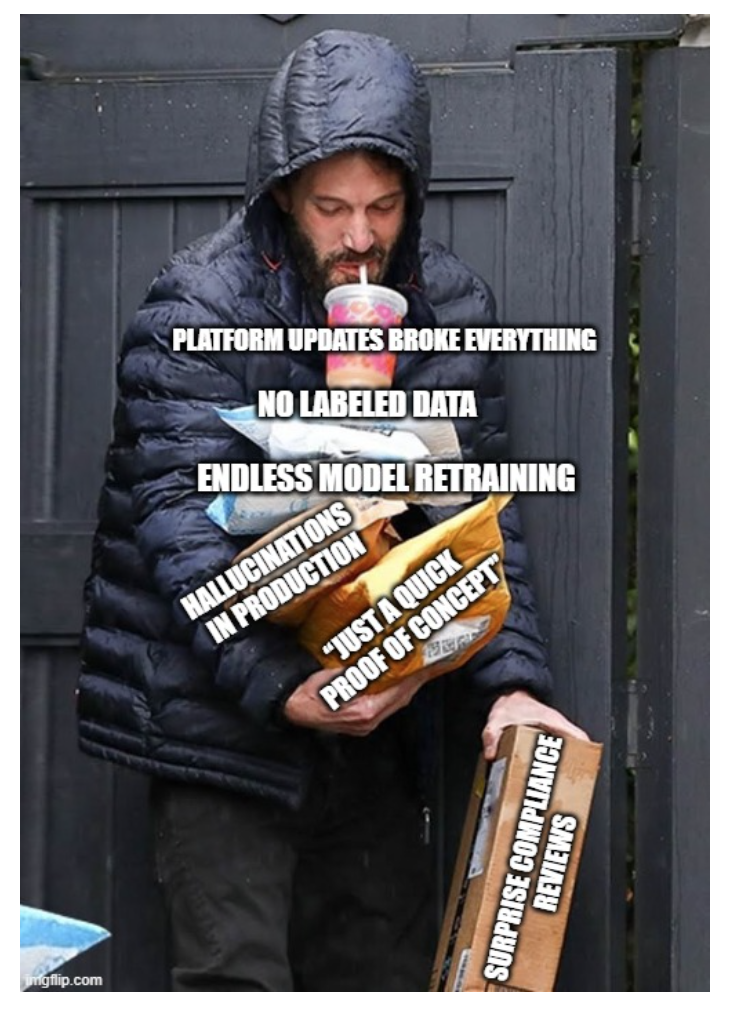Blueprint for a successful AI project
From chaos to clarity – how to build AI projects that actually work

If you’ve worked on an AI project recently, this probably isn’t a joke, it’s your backlog. For all the buzz around AI, many initiatives are still chaotic, short-lived, and poorly aligned with real business needs. The problem isn’t the technology but how we approach it.
And the landscape isn’t getting simpler. Especially in the Microsoft ecosystem, where customers are now faced with a growing menu of AI tools: Microsoft 365 Copilot for productivity, custom GPTs for tailored use cases, Copilot Studio for low-code automation, declarative agents for complex workflows. Each is powerful. Each promises value. But very few customers get clear guidance on what to use when and how these puzzle pieces fit together. This isn’t about a lack of choice, but about a lack of clarity. And clarity is exactly what AI projects need most.
Start with a problem, not a prototype
Too many AI initiatives begin with the tech. A new tool, a powerful model, or someone’s excitement about generative features. But without a clear, valuable problem to solve, even the most sophisticated solutions become expensive experiments. The right starting point is always the business challenge. What are we trying to change? What outcome defines success? And why is now the right time to tackle it with AI? If those questions aren’t answered upfront, the project isn’t ready, no matter how tempting the tooling looks.
Treat data like infrastructure, not a side task
Every successful AI initiative is built on data that’s available, trusted, and understood. That doesn’t happen by accident. It requires structure: governance, ownership, and often, a fair bit of human labeling work that rarely fits into the budget or timeline.
If the data isn’t usable, the model won’t be either. And if you’re not thinking about how that data will stay accurate over time, you’re not building a product, you’re making a throwaway demo.
Design for durability
Getting a model to produce decent results once is relatively easy. Keeping it accurate, explainable, and performant in a live system is not. That’s why so many PoCs vanish quietly after the initial excitement fades. From day one, design for monitoring, retraining, and change management. Make the system maintainable, auditable, and resilient to the inevitable drift in both input data and business priorities. A working model isn’t the end goal; it’s the beginning of a longer responsibility.
“Software being ‘finished’ is like the lawn being mowed. It’s not a state, it’s a moment.” - Ted Neward
Bring in compliance before it becomes urgent
Many teams delay thinking about legal, ethical, or regulatory implications until something breaks, or worse, ships. That’s not just risky; it’s expensive. Treat privacy, bias mitigation, and model explainability as design constraints, not edge cases. The earlier compliance gets involved, the more likely your solution is to make it to production…and stay there.
Assemble the right team
No single role can carry an AI project. Data scientists bring models to life, but without business context, domain expertise, and operational insight, even a technically brilliant model can misfire. The best AI outcomes come from cross-functional teams. Legal understands the risk. Ops knows the workflows. Designers think about trust and usability. Business leads connect the work to actual outcomes. AI isn’t a silo; it’s a team capability.
Measure outcomes, not just accuracy
It’s easy to over-focus on model metrics like precision, recall, confidence scores. They’re important, but they don’t tell you whether the project actually improved anything. Instead, measure impact: reduced costs, faster decisions, fewer errors, better customer experiences. And watch adoption. If no one uses the AI output, it doesn’t matter how accurate it is. Success means making the business better in ways that last.
Make AI boring
Commodity is the goal. Not shiny demos or endless PoCs, but systems that just work; models that can be trusted, maintained, and improved; solutions that quietly solve real problems and keep moving the business forward. Because right now, most organizations don’t need more AI options. They need AI decisions, based on purpose, not panic.
You May Also Like
A hill to die on: there are no tiny changes
In software, there’s no such thing as a harmless tweak. This post takes a look at the hidden costs of layout changes, typo fixes, and 'just one more thing' requests. It breaks down why every change, …
No, a crash course won’t make you an AI leader
Many organizations approach AI as a race with winners, deadlines, and quick wins. But AI isn’t a project—it’s a long-term capability. Inspired by Simon Sinek’s “infinite game” mindset, this article …
AI as a finite vs infinite game in organizations
Many organizations approach AI as a race with winners, deadlines, and quick wins. But AI isn’t a project—it’s a long-term capability. Inspired by Simon Sinek’s “infinite game” mindset, this article …





